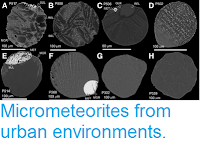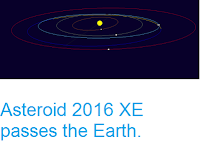Asteroid 2016 WJ1 passed the Earth at a distance of 8 050 000
km (about 20.9 times the distance between the Earth and the
Moon or 5.38% of the distance between the Earth and the Sun), slightly after 5.35 pm GMT on Friday 16 December 2016. There was
no danger of the asteroid hitting us, though if were to do so it would
present a significant threat. 2016 WJ1 is estimated to be
between 100 and 300 m in diameter, and an asteroid of this size would be
expected to pass directly through the atmosphere, striking the Earth's
surface and creating a crater between 1.2 and 13.6 km in diameter, as well as causing
devastation over a wide area and global climatic effects that could last for years or even decades.
The calculated orbit of 2016 WJ1. Minor Planet Center.
2016 WJ1 was discovered on 19 November 2016 (27 Days before its closest approach to the Earth) by the
University of Arizona's Mt. Lemmon Survey at the Steward Observatory on Mount
Lemmon in the Catalina Mountains north of Tucson. The designation 2016 WJ1
implies that the asteroid was the 34th object (object J1) discovered in the second half of November 2016 (period 2016 WJ1).
2016 WJ1 has a 566 day orbital period and an eccentric orbit
tilted at an angle of 2.89° to the plane of the Solar System, which
takes it from 0.67 AU from the Sun (i.e. 67% of he average distance at
which the Earth orbits the Sun, inside the orbit of the planet Venus) to 2.01 AU from the Sun (i.e. 201% of the
average distance at which the Earth orbits the Sun, and considerably
outside the orbit of the planet Mars). It is therefore classed as an
Apollo Group Asteroid (an asteroid that is on average further from the
Sun than the Earth, but which does get closer). This means that close
encounters between the asteroid and Earth are extremely common, with the
last having occurred in July 2009 this year and the next predicted
in March 2020. As an asteroid probably larger than 150 m in diameter
that occasionally comes within 0.05 AU of the Earth, 2016 WJ1 is also
classified as a Potentially Hazardous Asteroid.
2016 WJ1 also
has frequent close encounters with the planets Venus, which it is thought to have last passed in December 1993, and is next predicted to pass in May 2026, and Mars which it last came close to in March 2015 and is next predicted to pass in October 2029). Asteroids
which make close passes to multiple planets are considered to be in
unstable orbits, and are often eventually knocked out of these orbits by
these encounters, either being knocked onto a new, more stable orbit,
dropped into the Sun, knocked out of the Solar System or occasionally
colliding with a planet.
See also...







